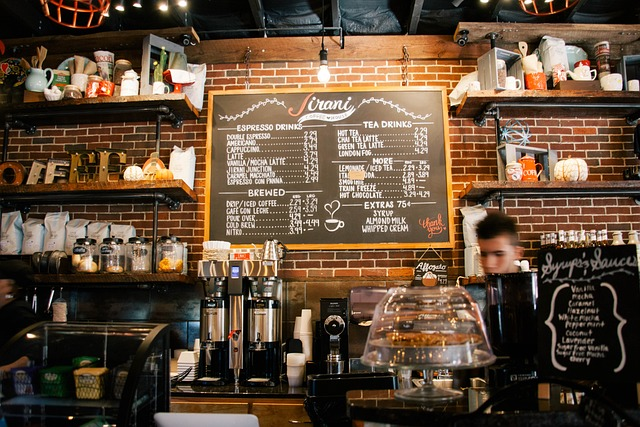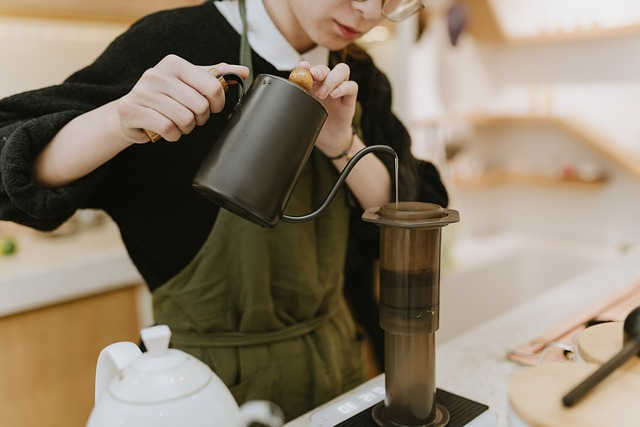So, you want to open a coffee shop in Australia?
With a vibrant coffee culture and a high demand for quality brews in Australia, the market is always seeing new entrants. However, opening a coffee shop requires careful planning and execution, especially in challenging economic times.
In this guide, I’ll walk you through seven essential steps to help you turn your dream into a reality. We’ll cover everything from market research to the grand opening.
Let’s get brewing!
Step 1: Conduct Market Research

Before diving into the cafe or coffee business, it’s crucial to understand the market. Australia has a strong coffee culture, and the industry has seen consistent growth, although cost of living pressures are seeing margins challenged across the industry. According to IBISWorld, the Australian coffee shop industry generated $10.7 billion in revenue in 2023, with an annual growth rate of 3.6% over the past five years.
To start, you’ll want to research:
-
Local Coffee Trends: Australians love their coffee, with a preference for high-quality, specialty coffee. Trends show a growing interest in sustainable and ethically sourced coffee beans, as well as a rise in non-dairy milk alternatives.
-
Target Audience: Identify who your customers will be. Are you targeting young professionals, students, or families? Understanding your audience will help tailor your offerings and marketing strategies.
-
Competition: Analyze your local competitors. Visit other coffee shops, observe their strengths and weaknesses, and identify gaps in the market that you can fill. Look for what makes successful cafes stand out and consider how you can differentiate your shop.
Step 2: Create a Business Plan
A well-crafted business plan is essential for your coffee shop’s success. It serves as a roadmap, guiding you through each stage of setting up and running your business. Here’s what your business plan should include:
-
Executive Summary: A brief overview of your coffee shop, including your vision, mission, and objectives.
-
Company Description: Detailed information about your business, including the name, location, and legal structure.
-
Market Analysis: Insights from your market research, including target market, customer demographics, and competitive analysis.
-
Organisation and Management: Information about the ownership and management team.
-
Products and Services: A description of the coffee and food items you’ll offer, along with pricing strategies.
-
Marketing and Sales Strategy: Your plan for attracting and retaining customers, including marketing channels and sales tactics.
-
Funding Request: If you’re seeking funding, outline how much you need and how you plan to use it. This should outline your coffee shop startup costs.
-
Financial Projections: Forecasts of your revenue, expenses, and profits.
Nadine Connell, a professional business plan writer at Smart Business Plans, emphases, “A business plan is not just a document; it’s a strategic tool that can drive your coffee shop business towards its goals. It provides clarity and direction, ensuring that all stakeholders are aligned.”
She adds, “Regularly updating your coffee shop business plan ensures that your plan remains relevant and reflective of your current goals and market conditions.”
Step 3: Secure Financing

Starting a successful coffee shop typically requires significant investment. Costs can include leasing or purchasing a space, renovating, purchasing equipment, and initial inventory.
Here are some common financing options:
-
Personal Savings: Using your savings can give you full control of your business without incurring debt.
-
Bank Business Loans: Traditional bank loans are a common financing option. You’ll need a solid business plan and good credit history to secure a loan.
-
Investors: You can seek investment from private investors or venture capitalists in exchange for equity in your business.
-
Government Grants and Subsidies: Check if you qualify for any government grants or subsidies for small businesses.
It’s essential to have a clear understanding of your funding requirements and sources. Detailed financial projections in your business plan will help convince lenders and investors of your business’s viability .
Coffee Shop Cost Calculator
Estimate the costs of starting your new coffee shop. Enter your details below:
Estimated Startup Costs
Total Initial Investment: $0
Fixed Costs (One-time expenses): $0
Variable Costs (Inventory + Working Capital): $0
Step 4: Choose the Right Coffee Shop Location
Location is critical to the success of your coffee shop. A high-traffic area with good visibility and accessibility will attract more customers. Consider the following factors when choosing a location:
-
Foot Traffic: Look for areas with high pedestrian traffic, such as shopping districts, near universities, or office complexes.
-
Competition: While competition can be healthy, avoid locations that are saturated with coffee shops unless you have a unique selling proposition.
-
Accessibility: Ensure the location is easily accessible by public transport and has adequate parking facilities.
-
Cost: Consider the cost of leasing or purchasing the property. Prime locations will cost more but can also bring in more business.
According to the Australian Bureau of Statistics, understanding the demographics of your chosen location can also provide valuable insights into potential customer bases and spending behaviors .
Step 5: Design Your Coffee Shop

The design of your coffee shop brand plays a crucial role in attracting and retaining customers. A welcoming and comfortable atmosphere encourages customers to stay longer and return frequently. Consider the following design elements:
-
Layout: Plan a layout that maximizes space while providing a comfortable flow for customers and staff. Consider seating arrangements, counter space, and kitchen layout.
-
Aesthetics: Choose a theme or style that reflects your brand. Whether it’s modern, rustic, or eclectic, ensure it resonates with your target audience.
-
Comfort: Invest in comfortable seating and ambient lighting. Consider offering free Wi-Fi and charging stations to attract customers who want to work or study.
-
Functionality: Ensure your design is functional and meets all health and safety regulations. Adequate ventilation, clean restrooms, and easy access for disabled customers are essential.
Step 6: Source Quality Equipment and Supplies
High-quality coffee shop equipment and supplies are essential for delivering excellent coffee and food. Here’s a list of the basics you’ll need:
-
Espresso Machine: The heart of any coffee shop. Invest in a high-quality machine that can handle high volumes.
-
Grinders: Freshly ground coffee makes a big difference in taste. You’ll need a grinder for espresso and possibly a separate one for drip coffee.
-
Brewers: Depending on your menu, you might need drip coffee makers, pour-over setups, or cold brew systems.
-
Refrigeration: For storing milk, food items, and perishable supplies.
-
POS System: A reliable point-of-sale system to manage orders, payments, and inventory.
-
Furniture and Decor: Comfortable seating, tables, and decor that align with your shop’s theme.
When sourcing coffee beans, prioritise quality and sustainability. Consider working with local roasters who can provide fresh, high-quality beans. Offering ethically sourced and fair-trade coffee can also attract conscious consumers.
Step 7: Market Your Coffee Shop

Effective marketing is crucial to attract and retain customers. Here are some strategies to get you started:
-
Online Presence: Create a professional website and active social media profiles. Share engaging content, updates, and promotions to attract followers.
-
Local Advertising: Utilise local newspapers, radio, and community boards to promote your coffee shop opening and special offers.
-
Events and Promotions: Host events such as coffee tastings, live music, or art exhibitions to draw in crowds. Offer promotions like loyalty programs or discounts to attract repeat customers.
-
Collaborations: Partner with local businesses for cross-promotions. For example, collaborate with a local bakery to offer joint specials.
Additional Tips for Success
-
Hire and Train Staff: Your staff can make or break your coffee shop. Hire friendly, skilled baristas and provide thorough training to ensure they can deliver excellent customer service and high-quality coffee.
-
Focus on Customer Experience: Consistently deliver a great customer experience. Listen to feedback, maintain a clean and welcoming environment, and ensure the quality of your products.
-
Adapt and Evolve: The coffee industry is dynamic, with trends and customer preferences constantly evolving. Stay updated on industry trends and be willing to adapt your menu and services accordingly.
Market Trends and Insights
The coffee culture in Australia is vibrant and evolving. According to Market Research Future, the Australian coffee market is expected to grow at a CAGR of 5.5% from 2021 to 2027 . Here are some notable trends:
-
Specialty Coffee: There is a growing demand for specialty coffee, with consumers willing to pay a premium for high-quality, ethically sourced beans.
-
Sustainability: Eco-friendly practices, such as using biodegradable cups and sourcing sustainable beans, are becoming increasingly important to consumers.
-
Non-Dairy Alternatives: The popularity of non-dairy milk alternatives, such as almond, soy, and oat milk, continues to rise.
-
Tech Integration: More coffee shops are integrating technology, such as mobile ordering and payment systems, to enhance customer convenience and streamline operations.
Getting help and support for your coffee shop business

For further guidance and support, consider visiting the following authoritative websites:
-
Business.gov.au: Offers resources and information for starting and running a small business in Australia.
-
Australian Coffee Traders Association (ACTA): Provides industry news, trends, and resources for coffee shop owners.
Expanding Your Coffee Shop Business
Once your coffee shop is up and running, you might consider strategies for expansion. This could include opening additional locations, offering catering services, or launching an online store for coffee beans and merchandise. Continually monitoring market trends and customer feedback will help you identify new opportunities for growth.
FAQs
Are Coffee Shops Profitable in Australia?
Yes, coffee shops can be profitable in Australia, some more than others of course. According to IBISWorld, the Australian coffee shop industry generated $10.7 billion in revenue in 2023.
However, profitability depends on various factors such as location, quality of coffee, customer service, and effective management. By understanding the market and implementing a solid business plan, coffee shops can achieve and sustain profitability.
Get a cash flow forecast to see how profitable your coffee shop could be.
How Much Does It Cost to Set Up a Cafe in Australia?
Setting up a cafe in Australia involves several costs, including leasing a space, renovations, equipment, initial inventory, and marketing. Here’s a breakdown of typical expenses:
-
Lease/Rent: Depending on the location of your coffee shop, leasing a space can range from $3,000 to $10,000 per month or more.
-
Renovations: Renovating the space to create a welcoming environment can cost between $50,000 to $150,000 or more, depending on the scale and scope of the work.
-
Equipment: High-quality equipment, such as espresso machines, grinders, refrigerators, and furniture, can total around $50,000 to $100,000.
-
Licenses and Permits: These can cost between $500 to $2,000.
-
Initial Inventory: Stocking up on coffee beans, milk, food items, and other supplies might require an initial investment of $5,000 to $10,000.
-
Marketing: An initial marketing budget of $5,000 to $10,000 can help promote your opening.
In total, the cost in setting up a cafe can vary a lot depending on what you’re trying to do, but on average we see costs from $150,000 to $300,000 or more, depending on various factors.
That’s why it’s essential for coffee shop owners to plan your budget carefully and secure adequate financing.
What License Do I Need to Open a Cafe in Australia?

Opening a coffee shop in Australia requires several licenses and permits to ensure you comply with local regulations. These include:
-
Business Registration: Register your business name with the Australian Securities and Investments Commission (ASIC).
-
Food Business License: Obtain a food business license from your local council, which involves meeting health and safety standards.
-
Council Approvals: Depending on your location, you may need planning permits, building permits, and outdoor dining permits from your local council.
-
Liquor License: If you plan to serve alcohol, you’ll need a liquor license from your state or territory’s liquor licensing authority.
-
Music License: If you plan to play music in your cafe, you’ll need a music license from the Australasian Performing Right Association (APRA).
Check with your local council and relevant authorities to ensure you have all the necessary licenses and permits before opening your coffee shop.
What is the Profit Margin for Coffee Shops in Australia?
The profit margin for coffee shops in Australia can vary widely depending on factors such as location, operating costs, pricing strategy, and overall efficiency. On average, the profit margin for a well-managed coffee shop can range from 10% to 20%. Here’s a closer look at the factors influencing profit margins:
-
Cost of Goods Sold (COGS): This includes the cost of coffee beans, milk, food items, and other supplies. Lowering COGS without compromising quality can help increase margins.
-
Operating Expenses: Rent, utilities, wages, and marketing are significant expenses. Managing these costs effectively is crucial for maintaining healthy profit margins.
-
Pricing Strategy: Setting competitive prices while ensuring a good markup on products is essential. Specialty coffee and premium offerings can command higher prices, contributing to better margins, if your coffee shop is in a location that has the income to support this.
-
Customer Volume: High foot traffic and repeat customers significantly impact profitability. Offering excellent service and a unique experience can attract and retain customers.
How to Start a Coffee Business from Home?
Starting a coffee business from home is a cost-effective way to enter the coffee industry. The steps are similar:
-
Market Research: Understand your target market and competitors. Identify a niche, such as specialty coffee, organic coffee, or cold brew, and a find a good coffee shop location.
-
Business Plan: Create a detailed business plan outlining your goals, target market, marketing strategies, and financial projections.
-
Licenses and Permits: Check with your local council about the required licenses and permits for a home-based food business.
-
Equipment: Invest in quality equipment such as coffee grinders, espresso machines, and brewing tools suitable for home use.
-
Sourcing Beans: Partner with local roasters or suppliers to source high-quality coffee beans.
-
Branding and Marketing: Develop a brand identity, create a website, and use social media to promote your business. Consider offering online sales or local delivery.
-
Compliance: Ensure your home setup meets health and safety regulations. This may involve inspections and adhering to food safety standards.
By starting small and focusing on quality, you can build a loyal customer base and gradually expand your business.
How Much Do Coffee Shop Owners Make in Australia?

The earnings of coffee shop owners in Australia can vary widely based on several factors, including location, size of the cafe, operating costs, and management efficiency. On average, coffee shop owners can expect to make anywhere from $60,000 to $120,000 per year.
Here’s what will influence your income, and whether you have a successful coffee shop:
-
Revenue: Higher sales volumes directly contribute to increased earnings. Prime locations and high foot traffic significantly impact revenue.
-
Profit Margins: Efficient management of costs and maintaining healthy profit margins are crucial for higher earnings.
-
Operational Efficiency: Streamlining coffee shop operations, reducing waste, and optimizing staff productivity can positively impact the bottom line.
-
Customer Loyalty: Building a loyal customer base through excellent service, quality products, and unique experiences can drive repeat business and steady income.
According to Nadine Connell from Smart Business Plans, “A new coffee shop owner may want to consider a coffee shop franchise if they are new to the industry. In this way they have an established brand, marketing, and operational support to get started.”
So, are you ready to open a coffee shop?
Starting a coffee shop business in Australia can be exciting journey, but it requires careful planning, research, and execution. By following these seven steps—conducting market research, creating a business plan, securing financing, choosing the right location, designing your coffee shop, sourcing quality equipment and supplies, and marketing your business—you’ll be well on your way to brewing success.
Remember, the key to a thriving coffee shop is delivering excellent coffee, creating a welcoming atmosphere, and providing outstanding customer service. Stay passionate about your craft, keep an eye on market trends, and be willing to adapt and evolve. With dedication and hard work, your coffee shop can become a beloved community hub and a successful business venture.

